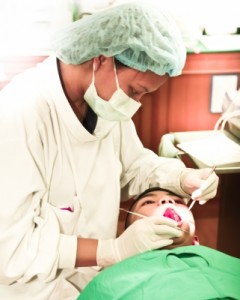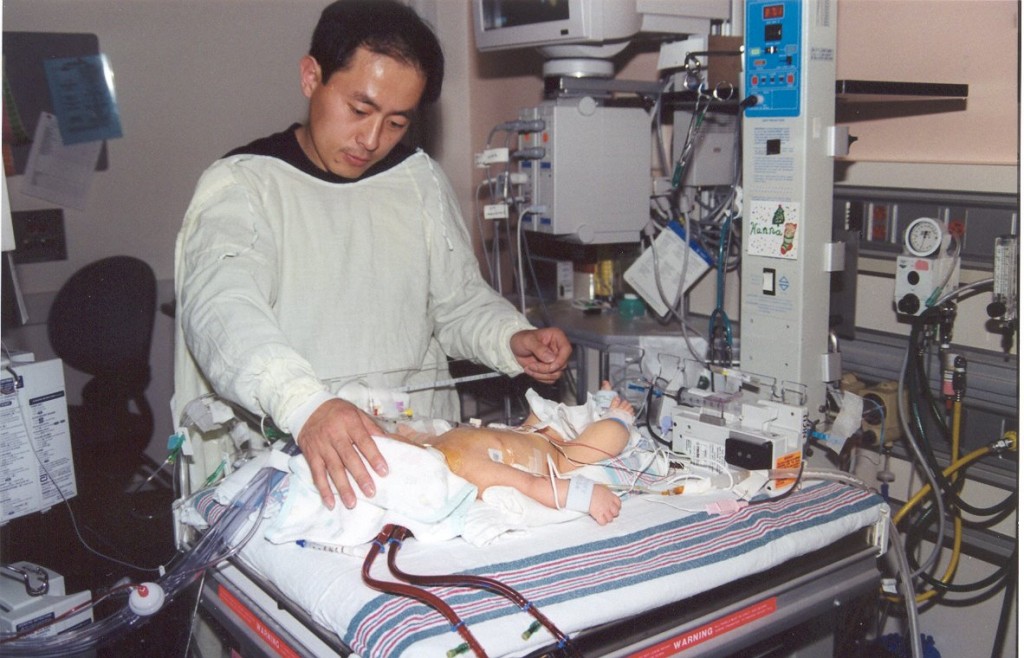Blog Archives
Crossword – Basic Vocabulary 7 (solution)
Writing Assignment: At the Dentist (Solution)
1. Why do people go to the dentist?
People go to the dentist for a dental checkup, and to have their teeth cleaned.
2. What is the boy in the picture doing?
He is getting a checkup and having his teeth cleaned by the dentist.
3. Why do people often avoid going to the dentist?
People often avoid going to the dentist because they are afraid it will hurt, or because they don’t like the sound of the dentist’s drill.
4. How often should you get a checkup?
You should get a dental checkup once every six months.
5. What does the dentist or hygienist look for during a checkup?
The dentist or dental hygienist looks for cavities during a checkup. He also looks to see how healthy your gums are. When the dentist cleans your teeth, he removes tartar (dental calculus) from your teeth.
6. How can the dentist find very small cavities that are hard to see during a checkup?
Sometimes there are cavities that are too small for the dentist to see in his visual inspection, so he can take an x-ray to see these tiny cavities.
7. What can you do to help prevent cavities?
Brushing after every meal, and flossing daily are important in helping to prevent cavities, because they remove plaque. If plaque remains on your teeth, the bacteria that live there produce acids which create the holes, or cavities, in your teeth. Other things that you can do to help prevent cavities are avoiding sugary foods and drinks, and using fluoride toothpaste and/or fluoride mouth rinse.
8. What happens if you have a cavity?
If you have a cavity, the dentist has to put a filling in it so it doesn’t get bigger.
9. When the dentist fills a cavity, what does he do first?
First, the dentist must drill the tooth to get rid of all the decay before he can put a filling in. Usually, he will give you some anesthetic (like a shot [or injection] of Novocain) to numb the area so you don’t feel anything.
10. What are fillings made of?
Fillings used to be made of amalgam, but these are not used so much anymore because they have trace amounts of mercury, and they don’t look very nice in the teeth. He can put in a gold filling, but gold is too expensive for most people. So it is most common to use bonding, where the color of the filling is close to the natural color of the tooth.
11. What happens if your tooth has a cavity that’s too big?
If the cavity is too big, the dentist might have to take off the part that’s above the gum line, and replace it with a crown. If the root is bad as well, the whole tooth might have to be pulled (extracted).
12. What can you do if you lose a tooth?
If you lose a tooth, you can replace it with an implant.
13. What can you do if you lose several teeth?
If you lose several teeth, you can replace all of them with implants. You can also use false teeth, or dentures, to replace the missing teeth.
14. What are some other things that the dentist can find wrong with your teeth or mouth?
The dentist can also tell if you have an impacted tooth, chipped teeth, or crooked teeth. The dentist can also tell if you have gingivitis, periodontal disease, or bad breath (halitosis).
15. Whom can you see if you have crooked teeth?
If you have crooked teeth and want to have them straightened, you can visit an orthodontist.
16. How can the orthodontist help you get straight teeth?
The orthodontist can help you get straight teeth by fitting you with braces.
17. How does a baby get teeth?
Starting around 5 months of age, a baby’s teeth will start to cut through the gum and grow in. We call this process teething.
18. What happens eventually to baby teeth?
The baby teeth become lose because the adult teeth underneath start to grow in, pushing the baby teeth out.
19. What are some things that different cultures do with baby teeth that have fallen out?
Some cultures throw the baby teeth over the roof of the house, some cultures bury the teeth in the ground, and some cultures put the baby tooth under the pillow, where it is taken by a fairy or a mouse.
20. What are the last adult teeth to come in?
The last adult teeth to come in are the wisdom teeth. The wisdom teeth are usually removed since they often don’t come in all the way, and become impacted.
Paragraph: A Visit to the Dentist
When you go to the dentist, he will have you sit in the dentist’s chair for your examination. He will put something like a bib around your neck, and tell you to open wide while he pokes around in your mouth, visually inspecting your teeth and gums for any problems. Wearing rubber gloves, the dentist will use his dental pick to clean your teeth, removing tartar from in between the teeth, under the gum line, and other hard-to-reach places. After that, he will polish your teeth with some special paste and a type of hand-held buffer. If he takes x-rays of your teeth, he will put a lead apron over your torso to prevent unnecessary exposure to radiation. Then he will insert the x-ray cards in your mouth and turn on the machine to take an x-ray.
If you need to have a cavity filled, the dentist will first give you some anesthetic – usually a shot of Novocain. This is to make your mouth numb in the area where he has to drill, so it won’t hurt. The dentist must drill to remove the decayed portion of the tooth before he fills it. He may use mercury (silver) amalgam, which is relatively inexpensive, or he may use bonding to fill the tooth with natural-colored resin fillings. Some people may wish to use gold for a filling instead, but of course this is more costly.
After he has finished working on your teeth, the dentist may tell you to rinse and spit. Part of the reason for this is to eliminate any debris, grit, or saliva that might remain in your mouth after the procedure, but the other reason is to get rid of any unpleasant taste.
As nice a fellow as your dentist might be, you probably don’t want to visit him any more than you have to. So you want to be sure that you floss at least once a day, and brush after every meal – these are small and easy but important steps that you can take to make sure that your teeth will last a lifetime, and to keep yourself in good dental health.
Grammar Basics: Unit 24 – Be, Have, and Do (Solutions)
Exercises: Complete the sentences by choosing a verb from the list, and using its correct form.
Example:
The library was (build) in 1956. ==> The library was built in 1956.
1. Where are you going?
2. John was waiting for the bus when his phone battery went dead.
3. They don’t have any bananas at the supermarket today.
4. The doctor didn’t do the operation today – he’ll do it tomorrow.
5. Was it raining when you woke up this morning?
6. He didn’t think that Katy was telling the truth.
7. When was the room painted?
8. Ice cream is made from milk.
9. Jack was injured when he was in the army.
10. Everybody was expecting the bad weather to come last night.
Grammar Basics: Unit 23 – Passive, Part II (Solutions)
Exercises: Use the present continuous (is/are being…) or the present perfect (has/have been…) with the words in the parentheses to complete the sentences.
Example:
The tree (cut) down tomorrow.==> The tree is being cut down tomorrow.
1. Don’t sit down on the sofa. It’s being cleaned right now.
2. We’re being invited to a wedding on Saturday, so keep your schedule open for that day.
3. The president’s speech is being broadcast on TV tonight.
4. You’ll have to wait to do the laundry. The washing machine is being fixed.
5. Our living room is being painted, so we are spending the day at the mall.
6. Your grandmother’s wedding dress has been repaired, cleaned, and boxed up, so it’s as good as new.
7. The window has been broken! Which one of the neighborhood kids did it, do you think?
8. Twelve trees have been cut down to make space for a swimming pool.
9. Sorry I’m late. The bus has been tied up in traffic for 30 minutes.
10. The grass has already been mowed, so you can cross that off your chore list.
Writing Assignment: The Subway (Solution)
1. What are these people doing?
They are riding on the subway.
2. Where might they be going?
They might be going to work or to school.
3. How crowded is this subway train?
It is rather crowded. There is standing room only – there are no seats left for someone to sit down.
4. Are there more people standing, or more people sitting?
There are more people standing than there are sitting.
5. What do people usually hold on to if they have to ride standing up?
If people have to ride standing up, they usually hold on to a strap, or a pole.
6. Does a subway train usually have seats or benches?
A subway train usually has benches.
7. What do people usually do if they are carrying baggage or packages?
If people have baggage or packages, they usually put them on the floor, or on one of the overhead racks.
8. What do people often do when they ride on a subway train?
People riding on a subway train often read a book or newspaper, or listen to music. Some people even sleep.
9. What do you need to get on the subway train?
You need a ticket, token, or fare card to get on the subway train.
10. Where can you buy a ticket?
You can buy a ticket at the ticket window, or at a ticket vending machine. You can also get your fare card reloaded at these places too.
11. What kind of gate do people usually pass through to get into the subway?
You have to pass through the turnstile to get into the subway. You swipe your ticket or fare card, and the turnstile will let you into the subway.
12. What do you call the place where you get on and get off the subway train?
You get on and off the subway train at the station.
13. How can you tell where to get on and get off?
A subway map or guide can tell you where you need to get on and off.
14. What do you do if you have to take more than one line to get to your destination?
If you have to take more than one line to get to your destination, you need to transfer to the other line.
15. How can you tell if your stop is next?
You can look at the subway map or guide to see if your stop is next, or you can listen to the announcement.
16. What kind of subway train has fewer stops than normal?
An express train has fewer stops than normal.
17. What might you see on the walls of the subway train?
You might see advertisements on the walls of the subway trains.
18. What kind of doors does a subway train usually have?
A subway train usually has sliding doors. You have to be careful that your coat or bag doesn’t get caught in the doors as they close.
19. What sort of safety equipment would you see in a subway?
You see fire extinguishers in a subway.
20. What else might you see in a subway?
You might see vending machines, newspaper stands, and other little shops in a subway.
Paragraph: The Subway
If you live in a city, a subway is a very convenient way to get around. You don’t have to deal with traffic and parking, so you can usually get to your destination quicker than driving. Many big cities have an extensive subway line, so you can get to almost any place in the city quickly, easily, and economically.
Paying the far is easy. You can buy a fare card with a set amount, and swipe the card every time you go through the turnstile to ride the subway. When the card gets low, you can reload the card with money and continue using it. Some places even have fare cards with different decorations, so you can collect the various designs.
A subway map or guide is a very handy item to have, especially if you are not familiar with the system. The map will tell you where the different lines will take you, so you can plan out your trip and determine which lines you need to take, which station you need to get on at, which station you need to transfer lines, and which station to get off at. What I like to do is highlight the stations I need to get off at, so I can keep track of where I’m going and not get lost.
Because the subway is so convenient, many people ride the subway. Sometimes it is very crowded, especially during the morning rush and the afternoon rush. If you ride the subway during the rush times, you will probably have to stand. Sometimes there are so many people standing, it looks like wall-to-wall people! In some places there are so many people waiting to get on the subway that there are “pushers” to help get as many people on the subway car as possible, although I must admit I have never seen “pushers.”
Sometimes if there are elderly people, pregnant women, or someone traveling with very small children, other people will stand up and offer their seat to one of these others, so they don’t have to stand up. That is a nice thing to do, don’t you think?
Grammar Basics: Unit 22 – Passive, Part I (Solutions)
Exercises: Complete the sentences by using the passive (either present or past) of the indicated verb.
Example:
The baby (give) a bath yesterday. ==> The baby was given a bath yesterday.
1. We had a snow day last week, so classes were canceled.
2. The librarian charged me a fine because several pages of the book were torn.
3. Can I exchange these jeans for some new ones? The zipper is broken.
4. The kitchen was cleaned during the night by some good fairies.
5. The old factory was burned down by a firebug.
6. There was an accident on the highway, and several people were taken to the hospital.
7. Jack was born on a fishing trawler.
8. Tom was woken up in the middle of the night by the baby’s crying.
9. The old lady was helped across the street by a Boy Scout.
10. That picture was taken on our honeymoon.
Grammar Basics: Unit 21 – Present Perfect vs. Simple Past, Part III (Solutions)
Exercises: Use the words in parentheses to make the sentence either present perfect or simple past.
Example:
(you / ever / go) skiing? ==> Have you ever gone skiing?
(you / go) skiing last year? ==> Did you go skiing last year?
1. Tom has lost his key. Can you help him find it?
2. I’ve been looking for you. Where have you been?
3. What did you eat for lunch yesterday?
4. Matt has taken piano lessons since he was eight years old.
5. Last week we got a lot of snow.
6. I have traveled around the world, but I have never tasted anything as delicious as this barbecue.
7. This morning I exercised before I went to school.
8. Mother has made a delicious dinner for tonight’s party.
9. Have you ever had Mr. Smith as a teacher?
10. Where did you live ten years ago?
Writing Assignment: At the Hospital (Solution)
1. What is the man in the picture doing?
He is visiting a baby, and he has his hand on the baby’s head.
2. What sort of covering is the man wearing?
He is wearing some scrubs.
3. Why is the man wearing scrubs?
The man is wearing scrubs because the baby has to be in a sterile environment, and be protected from germs.
4. Where is the baby?
The baby is lying on a small baby hospital bed.
5. Why doesn’t the man pick up the baby?
The baby is hooked up to a lot of tubes and various monitors.
6. Why aren’t there other visitors for the baby?
The number of visitors is limited, and only the baby’s parents or close relatives can visit.
7. Is this a regular hospital room?
No, this is a neo-natal intensive care unit (NICU).
8. Is the baby’s condition critical?
Yes, the baby is rather sick.
9. How many tubes are hooked up to the baby?
We see a couple of big tubes coming out near the baby’s head, and there are several other tubes on the baby’s body.
10. What sort of monitors is the baby hooked up to?
The baby is hooked up to a heart rate and blood pressure monitor, as well as monitor that checks the baby’s respiration.
11. How do the monitors help the nurses see how the baby is doing?
The monitors help the nurses by keeping track of the how the baby’s blood pressure, breathing, and heart rate (vital signs) are doing.
12. What would the monitors do if the baby’s blood pressure or heart rate goes too high or too low?
If the baby’s vital signs go too high or too low, the monitors will sound an alarm to alert the nurses that there is a problem, and the baby needs attention.
13. What kinds of information would the nurses write down in the patient’s chart?
In the baby’s chart the nurses would write down the heart rate, blood pressure, respiration, in addition to other information like what kind of medication the baby is being given, and when the last time was that the baby received some medication.
14. What sort of things would the nurses do to take care of the baby?
In addition to watching the baby’s monitors and recording the information, the nurses would give the baby medication, change the IV when necessary, change the baby’s bandages and cleanse the baby’s incisions, or change the baby’s catheter and empty the urine bag.
15. What does a nurse use a stethoscope for?
The nurse uses the stethoscope to listen to the baby’s heart, lungs, and intestines.
16. How does the nurse take the baby’s temperature?
The nurse uses a thermometer to take the baby’s temperature.
17. How would a sick baby like this be fed?
A sick baby like this would probably be fed intravenously, or possibly through a nose tube.
18. How would a sick baby like this be given medicine?
A sick baby like this would be given medicine intravenously.
19. What do the nurses or doctors do if the baby needs extra blood?
If the baby needs extra blood, the doctors or nurses would give the baby a blood transfusion.
20. How long do you think it will be before the baby can go home?
Since the baby is so sick, it will probably be a few weeks before the baby is well enough to go home.
Paragraph: At the Hospital
Write a brief paragraph about the time that you, or a friend or relative, were in the hospital. How was the stay in the hospital? Were the doctors and nurses friendly and helpful?
When our first baby was born, she was very sick because of a condition called meconium aspiration. This happens when the baby has a bowel movement inside the womb and then inhales the fecal matter. This can be a very serious condition, because the meconium coats the lungs and makes it difficult for the baby to get enough oxygen. Our baby needed to be transferred to another hospital where the doctors could operate on her to hook her up to an ECMO (extracorporeal membrane oxygenation) machine to give her lungs a chance to heal and recover. While she was on the ECMO machine, she was in NICU, so we had to wear scrubs to visit her. The visiting hours were limited, and only parents and grandparents could visit, just two at a time. After three or four days, she was able to come off the ECMO machine, but she still needed to be in NICU until her vital signs were healthy. About twelve days after she was born, she was able to come out of NICU and be transferred back to the local hospital, but she still was unable to come home. She had to gain weight and learn how to nurse or feed from a bottle. Eventually, she was healthy enough to be discharged from the hospital, and we took her home on Christmas Eve, over three weeks after she was born.
Grammar Basics: Unit 20 – Present Perfect vs. Simple Past, Part II (Solutions)
Exercise: Rewrite the sentences using the present perfect.
Example:
Did Kelly go on vacation yet? ==> Has Kelly gone on vacation yet?
1. I haven’t told my father yet that I lost my job.
2. Tim has already shoveled the snow from the sidewalk.
3. Sam’s just taken a shower.
4. Have you just gotten home from work?
5. Oh, I’ve already put away the groceries.
6. Have you changed the baby’s diaper yet?
7. We’ve just bought a new dishwasher.
8. Steve’s already graduated from college.
9. Dave hasn’t voted yet.
10. I’ve just turned on the radio.
Exercise: Rewrite the sentences using the simple past.
Example:
The guests have already come! ==> The guests already came!
1. Matt didn’t eat dinner yet.
2. The TV repairman just left.
3. Mr. Jones is not in. He already left for the day.
4. Do you want to talk to Bill? He didn’t go to bed yet.
5. Help! I was just robbed!
6. She already celebrated her birthday.
7. The baby didn’t get any teeth yet.
8. The baby just said “Dada” for the first time.
9. Did you talk to your cousin yet?
10. Mary already returned the books to the library.





